- All you wanted to know about Handlooms of
Kerala-Kasavu, Balaramapuram and Kuthampully sarees-Mundu-Lungi etc.
The
cultural variety of Kerala is created by its unique geographic features as it
lies between the Arabian Sea and the Western Ghats. Rich in rain forests,
ancient trade relations with foreign lands, entry of immigrant communities,
agricultural tradition, cuisine and its tradition of art – literature –science
and all these make the state of Kerala.
“Traditional attires like sarees, mundus, and settu
mundus are generally called kaithari
which means handloom.” 1 Textiles
and handlooms of Kerala are renowned for their craftsmanship, design, colours
and simplicity. They are woven by skilled artisans whose families have been in
the profession for centuries. Some of the popular items you can buy include the
famous white Karaikudi sarees with a golden band on the border.
The
Balaramapuram sarees and Kuthampully sarees are also high in demand and can be
easily found in the saree shops of Kumarakom.
The
textile products of Kerala are made with materials like cotton, coir, sisal,
jute and palm fibres. The state is home to a number of cooperative handloom
societies that supply cotton yarns and other required weaving accessories. Most
of the textile products in Kerala are crafted by weavers in their homes using
different types of looms like pit looms and frame looms.
The
state generally weaves undyed, off-white cotton cloth with coloured or golden
borders. Single and double mundu, mundum neriyathum (settumundu) i.e. traditional
white cotton dhotis and sarees are its traditional dresses. Fabric is bright
and elegant. Excellent texture and structure of the cloth, unique colour
combinations and traditional craftsmanship have made it popular.
These
pure cotton cloths are manufactured using eco-friendly methods. Apart from a
well-connected chain of co-operative societies, several places from Trivandrum
to Kasargod are traditionally active in handloom production. Many of them bear
geographical index as well.
Kerala
handloom products have roots in specific locations i.e. Balaramapuram in
Trivandrum, Chennamangalam in Ernamkulam, Kuthampully in Thrissur and parts of
Palakkad, Kannur and Kasargod districts.
Dyeing,
winding, warping, denting and joining, beaming and weaving are the main stages
in production. South and central Kerala are famous for weaving of superfine
dress varieties while north Kerala concentrates on both coarser and soft varieties
of home furnishings and linen. Kasargod is famous for sarees that have many
similarities with Karnataka Mangalore style.
The
handloom sector has traditionally been one of the most vibrant and profitable
in the state with a distinct brand identity. They are keeping pace with changing
fashion trends, but without losing their uniqueness. New colour combinations
are added, ornamental works introduced and designer elements appended.
The very charm and elegance of these items, ideal for the state's hot and humid weather, make it an inevitable part of the Malayali wardrobe and celebrations. The lightweight nature and coarse texture make them comfortable. Kerala handloom varies slightly from place to place. Some of the weave mundu and saree with thin golden borders and pallu, others with heavy ornamental brocades, a third has coloured borders. Some fabrics are lightweight and some slightly heavier. In certain places, weavers use half-fine zari for ornamentation to reduce product price.
Initially,
all weaving was done at homes with pit looms. Women helped in fixing and
starching warp and weft. The younger generation left home for higher studies
and jobs. So few or no looms are seen in households now.
Kasavu Saree

Kasavu is
a soft, white or off-white handloom cotton cloth with gold-threaded
borders.
“The term kasavu refers to the zari (gold
thread) used in the border of the Kerala saree.”1 The original kasavu cloth was
made by hand from cotton yarn and the borders from golden threads. It is
believed to date back to the Buddhist era and continues to be worn
by Malayalis. It is worn by both women and men, especially during festivals,
dance programs, and special occasions such as weddings and piranna naal (birthdays according
to the local calendar.)
During
the Vishu festival, it is customary to place a brand
new kasavu cloth near the traditional Vishukkani (lamp) as
a symbol of wealth and prosperity. During dance performances such as the Mohiniyattam (dance
of Vishnu in female form), only kasavu garments are worn by
participants. Dances such as Kaikottikali or Thiruvathirakali (dance of clapping) also have women
performers wearing kasavu sarees and traditional red blouses.
Styles
Garments
made with kasavu are long, rectangular pieces of cloth called
the mundu, wrapped around the lower body, and
the veshti, wrapped around the upper body. Women typically wear a
red, green or gold traditional blouse under the veshti while men
sometimes wear a formal shirt.
The cost of a "kasavu set" or "kasavu settu" comprising the mundu and veshti varies according to the width of the gold borders. Borders can range from 3/4" or less, to 6" or more in width.
Modern kasavu
The
traditional mundu-veshti has evolved over time and women prefer to
wear a single-piece saree rather than the original two-piece garment. Also, the
original garments had pure gold borders, whereas the newer versions have red, green,
orange etc. colours along with gold, to make them look more attractive. Power
looms are also replacing handlooms but the machine-made fabric differs in
texture from the original, though they are cheaper to produce.
Traditional
attires like sarees, mundus, and settu mundus are generally called kaithari which means handloom. The
identity of the saree comes from the geographical cluster they are associated
with. The Indian government has identified three clusters in Kerala -
Balaramapuram, Chendamangalam and Kuthampully - that have been given a
Geographical Indication (GI) tag. All three clusters produce kasavu sarees.
How long does it
take for a kasavu saree to be made?
A
plain saree with a simple border takes roughly around three to five days. Ones with
motifs and heavier work take longer. The sarees are priced depending on the
time taken to produce and quantum of gold used in the zari or kasavu.
The
traditional white and gold kasavu saris worn on festivals like Onam or Vishu
adds to the colour and vibrancy of celebrations. The crisp cotton cream and
gold six yards that women drape during the main festivities and even during
weddings exude a sense of elegance and richness in its simplicity.
1.
All
you wanted to know about the Kasavu saree
2.
To see nice
pictures of different types of Kasavu saris
3.
Different
Blouse designs for Kasavu sarees
4.
How
to Identify Original Kasavus sari – Video 12 minutes
5.
History
of White and Gold Kasavu Sarees
2. Kuthampully Saree
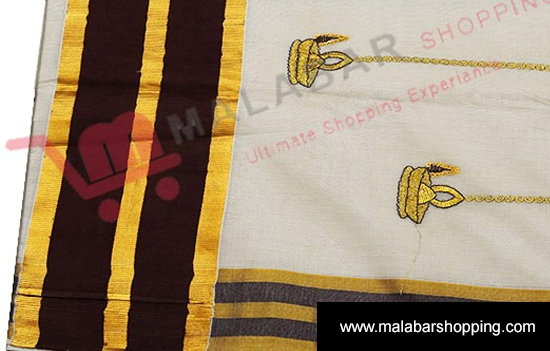
Kuthampully
Saree is a type of Sari traditionally made by weavers from Kuthampully
village in Thiruvilwamala Grama Panchayat of Thrissur district, Kerala.
The Kuthampully Saree is distinguished by its borders.
History
In
1972, Kuthampully Handloom Industrial Cooperative Society was registered with
102 members. Their caste was Devanga Chettiar originating from Bangalore and
Mysore. Now it has 814 members with own building in Kuthampully.
A
traditional cotton weaver’s village with around 600 Brahmin families,
Kuthampully is well known for kasavu handloom weaving. Kuthampully saris are a
favourite among womenfolk not only in Kerala, but also in other parts of India.
They followed the traditional path in the early days and their different kinds
of Indian clothing like kasavu double dhoti, veshti and set mundu have become
popular.
Later
on, embroidery techniques have been deftly applied on traditional Kuthampully
sarees to produce designer ones. At present around 3,000 people are employed in
this sector mostly through cooperatives and small-scale entrepreneurs.
Kuthampully
is a small town situated in Thrissur District in Kerala. The major item of
Kuthampully Saree is manufactured in Grey Style with Kasavu (Zari). This traditional
product is woven with 80s, 100s fine count cotton yarn. These sarees are
manufactured at Kuthampully, Thiruvilwamala, Eravathody and Kondozhi regions.
Weavers from Tamil Nadu migrated to these areas during 1200-1700 AD and started
weaving these sarees there.
Material used
The
materials used for the weaving of Kuthampully Sarees are 80s and 100s cotton
and for zari locally called as ‘Kasavu’.
Technique
applied: The border is woven in extra weft zari designs by using
dobby/jacquard. Buti designs are also woven on the body of the saree with zari.
The pallu of the saree is woven with zari by using jacquard. Specialty of the saree lies in preparation of
warp thread in “street sizing” technique. The warp threads become almost round
and uniform in shape after sizing so that the saree has very clear surface
without any protruding fibres on it.
How to distinguish
a genuine Kuthampully Saree?
Designs
appear very prominently in both side borders, body and pallu. Sarees are mostly
woven with undyed yarns like Balarampuram Sarees. Basic texture i.e., thread
density of the fabric is higher than that of similar cotton sarees.
Less
starchy finish in the saree gives softer touch. Kuthampully Saree is
handmade, with each design and motif being carefully handwoven into the fabric
by the weavers.
Nice site for
variety of sarees
Video Kuthampully Weavers
Village
3. Balaramapuram Saree
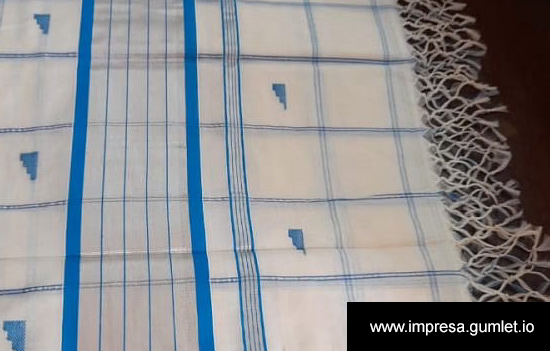
Balaramapuram is a small village in the Thiruvananthapuram district of
south Kerala, famous for fine cotton sarees and dress materials. It is woven
from un-dyed natural cotton which suits the tropical climate of Kerala. It is
usually a cream stretch of cloth with “Kasavu”/zari borders.
The weavers belong to the Saliya community who migrated from Nagarcoil
and Thirunelveli in modern day Tamil Nadu. The sarees and textile products of
Balaramapuram are magnificent in their un-dyed natural colour cotton yarn and
inter-woven with zari. The product is basically a cream stretch of cloth with
gold zari embroidered in the Pallu and body. It is known for the delicate
threading and vibrant colours.
Traditional handwoven Balaramapuram sarees come with a golden zari weave,
a wide golden zari border with golden lines throughout the saree and pallu
paired with a matching blouse piece. Today, the reputation of Balaramapuram
handloom products has spread far and wide.
Credits or Wedding
design saree
Good
read – Preserving the famous legacy of the weavers in Balaramapuram
Video
on Balaramapuram Village Visit – Good 8.40 minutes
Other Textiles
Erettu Thorthu/Erezha Thorthu/Mangadan
Thorthu
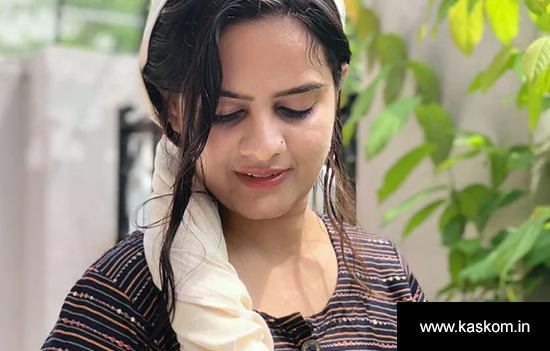
Thorthu
is a towelling fabric made of cotton yarn. It absorbs the moisture quickly due
to its loose structure. It is woven in plain weave using two heald shafts. The
warp is drawn 1-1-2-2 order, that is, the first two yarns are drawn
through the two heald eyes of the first heald and third and fourth yarns are
drawn through the two heald eyes of the second heald shaft. Then the first two
yarns of the first heald shaft are drawn through the single split or dent of
the reed and the third and fourth yarns of the second heald shaft are drawn
through the second dent of the reed and so on. Due to this, the fabric woven
will give the appearance of a mat weave in 2 and 2 order.
Credits
Kaili or Lungie
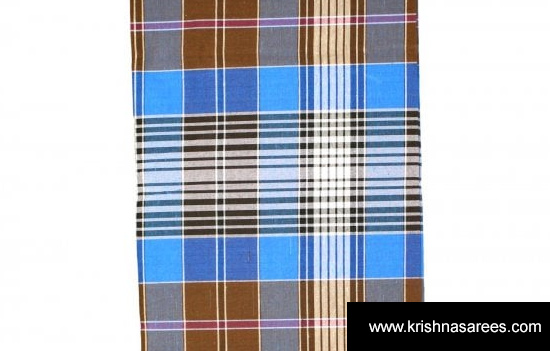
Kaili
or Lungi is worn by the gents of Kerala. It is usually made of cotton but sometimes
in poly cotton blends too. The kaili or Lungi designs are either in checks or
stripes of vivid colour combinations. In olden days the yarns were dyed using
Naphtol/Azoic dyes, nowadays it is completely replaced with vat and reactive
dyes.
Credits
Double Dhothi or Double Mundu
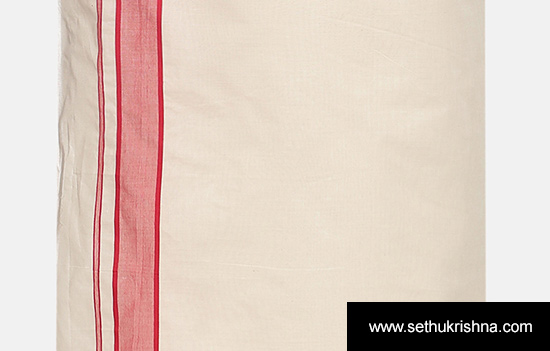
Double
Mundu or Double dhoti is gents’ formal wear. The dhoti has a small border and
cross border, 1 to 2.5 inches wide, on both sides. Dark colours are used for
these borders. The body is off white colour. Zari yarns are also used in
borders and cross borders.
Credits
The
purpose of this compilation is to document and promote. We have given credits
and reference links in this compilation along with third party links (to
promote). In case some are missed, it is not with malafide intent. Please
email full details to esamskriti108@gmail.com
and we shall effect the change.
To read all
articles by author
To
read all articles on Traditional Indian Textiles of India
Author Trishna
Patnaik
is a self-taught
artist based in Mumbai, Trishna has been practising art for over 14 years. She
is now a full-time professional painter pursuing her passion to create and
explore to the fullest. She conducts painting workshops across India. She is
also an art therapist and healer who works with clients on a one to one basis.
Not to forget her quality writings on Indian Art and now Textiles for
esamskriti. She fancies the art of creative writing.